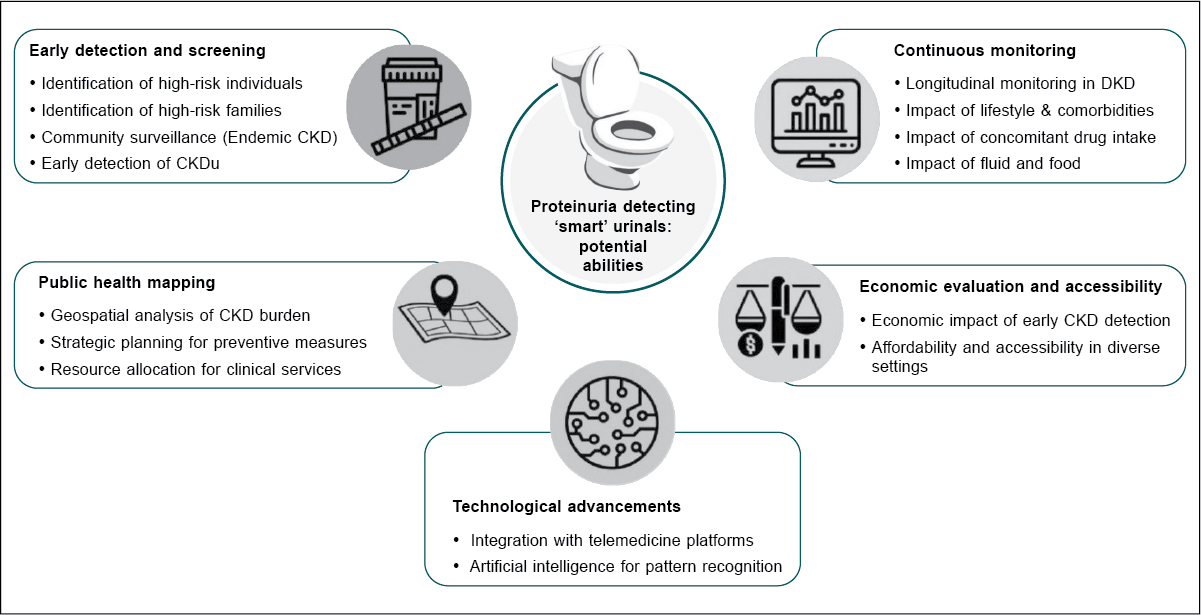https://doi.org/10.59793/ijcp.v34i8.763
Abstract
Chronic kidney disease (CKD) poses a considerable health challenge, particularly in populations with high-risk factors such as diabetes and hypertension. This article proposes a novel and cost-effective approach to address this concern by integrating proteinuria detection technology into urinals. We suggest the installation of these innovative ‘smart’ urinals in homes of individuals with diabetes, offering a convenient and proactive means of monitoring kidney health. Furthermore, the deployment of such ‘smart’ urinals in public places could serve as accessible screening facilities, enabling early detection of CKD in a broader population. The potential cost-benefit ratio of this approach is highlighted, emphasizing the long-term economic benefits associated with early intervention. We argue that the proposed technology has the potential to revolutionize CKD screening, providing a valuable tool for individuals at risk and contributing to the global effort to mitigate the impact of CKD on public health. Further research and pilot programs are warranted to explore the feasibility and effectiveness of this innovative screening strategy.
Keywords: Chronic kidney disease, diabetes mellitus, diabetic nephropathy, urinalysis, screening tool, public health, continuous home monitoring
Chronic kidney disease (CKD) poses a significant global health challenge, with diabetic kidney disease (DKD) being a prominent contributor.1 Early detection and intervention are crucial in managing CKD,2 especially in high-risk populations such as individuals with diabetes.2 In this commentary, we propose the integration of proteinuria detection technology into urinals as a novel and cost-effective approach for screening DKD, both in home and public settings.
RATIONALE
Proteinuria is an early indicator of kidney dysfunction and a common marker for DKD.3 Current screening methods often involve laboratory tests that may not be readily accessible or convenient for routine monitoring. The implementation of urinals equipped with proteinuria detection technology could serve as an unobtrusive and efficient means of early DKD detection.
In 2020, Park et al4 created mountable toilet systems with readily deployable hardware and software, allowing for the collection and analysis of data related to human health. This advanced ‘smart’ toilet, equipped with intelligent technology, assesses urine by employing a colorimetric assay that derives red-green-blue values from images of urinalysis strips. Additionally, it utilizes computer vision as a uroflowmeter to compute urine flow rate and volume, and categorizes stool based on the Bristol Stool Form Scale.4 Figure 1 depicts the potential abilities of proteinuria detecting ‘smart’ urinals.

Figure 1. Potential abilities of proteinuria detecting ‘smart’ urinals.
HOME INSTALLATION
For individuals with diabetes, especially those with risk factors for CKD, having proteinuria-detecting ‘smart’ urinals at home could offer a proactive approach to monitor kidney health. This home-based screening tool would empower individuals to take charge of their health by enabling regular, noninvasive monitoring and facilitating early intervention in case of abnormal results. Nonetheless, this technology can also be helpful in screening the relatives who are at higher risk of developing DKD.5
PUBLIC HEALTH IMPACT
Installing such urinals in public places could have a substantial impact on the early detection of CKD in the broader population. Public facilities would serve as accessible screening points, allowing individuals without prior knowledge of their CKD risk to discover potential kidney issues. Early detection may lead to timely medical intervention, reducing the overall burden of CKD and associated health care costs.3 This is especially important for communities where CKD is endemic, i.e., endemic CKD or CKDu (CKD of unknown etiology).6
COST-BENEFIT RATIO
Considering the high financial burden associated with CKD treatment, the proposed proteinuria-detecting urinals offer a potentially low-cost solution for early screening and intervention. The initial investment in installing this technology could be outweighed by the long-term savings resulting from reduced CKD-related health care expenses.
CONCLUSION
In conclusion, the integration of proteinuria detection technology into urinals represents an innovative and accessible approach to screen for DKD. This proactive method has the potential to revolutionize early detection strategies, particularly for individuals with diabetes who face an elevated risk of CKD.
The implementation of such urinals at both home and public locations could contribute significantly to the global effort to mitigate the impact of CKD on public health. Further research and pilot programs are warranted to explore the feasibility and effectiveness of this novel screening approach.
Authorship Confirmation/Contribution Statement: SS and SK were involved in literature search, planning, conduct and writing the original draft of manuscript. SS, SK, SBR and HV were involved in editing of the study. All the authors have agreed with the submitted manuscript. SS is corresponding author and guarantor for all.
Authors’ Disclosure (Conflict of Interest) Statement: The authors declare that they have no conflicts of interest regarding current study.
Funding Statement: The current study is not funded by any source.
REFERENCES
- Thomas MC, Brownlee M, Susztak K, Sharma K, Jandeleit-Dahm KA, Zoungas S, et al. Diabetic kidney disease. Nat Rev Dis Primers. 2015;1:15018.
- Nagib SN, Abdelwahab S, Amin GEE, Allam MF. Screening and early detection of chronic kidney disease at primary healthcare. Clin Exp Hypertens. 2021;43(5):416-8.
- Gorriz JL, Martinez-Castelao A. Proteinuria: detection and role in native renal disease progression. Transplant Rev (Orlando). 2012;26(1):3-13.
- Park SM, Won DD, Lee BJ, Escobedo D, Esteva A, Aalipour A, et al. A mountable toilet system for personalized health monitoring via the analysis of excreta. Nat Biomed Eng. 2020;4(6):624-35.
- Carpena MP, Rados DV, Sortica DA, Souza BM, Reis AF, Canani LH, et al. Genetics of diabetic nephropathy. Arq Bras Endocrinol Metabol. 2010;54(3):253-61.
- Arambegedara D, Jayasinghe S, Udagama P. Multi-pronged research on endemic chronic kidney disease of unknown etiology in Sri Lanka: a systematic review. Environ Sci Pollut Res Int. 2022;29(4):4893-910.